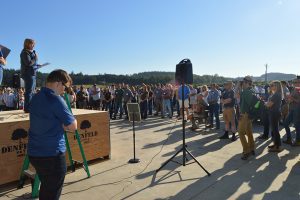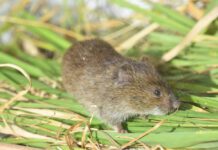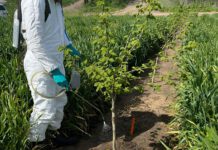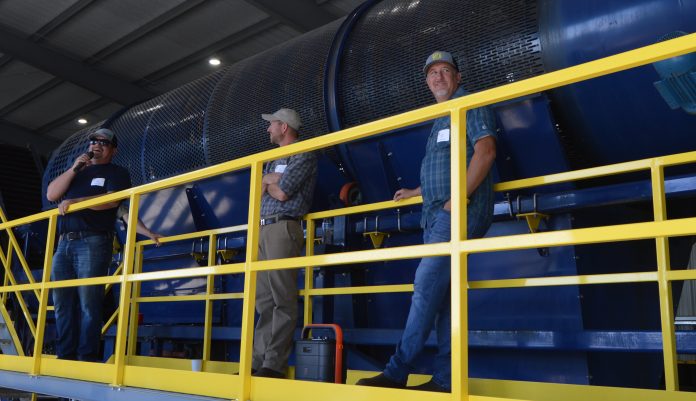
Hundreds of hazelnut growers, processors and others gathered at a state-of-the-art receiving station in Albany, Ore. in August for the Oregon Hazelnut Industry’s first full-scale Summer Tour in three years.
“We are thrilled with the turnout,” said Colleen Nihen, executive director of the Hazelnut Industry Office, who said more than 700 were on-hand. “It is evident that COVID-19 is ending, and we are finally able to get back together.”
Participants heard about sucker control, soil health and general orchard management during morning breakout sessions that pivoted around a presentation on the K&D Systems receiving station.
Tim Newkirk, a Canby grower who helped with the system’s design, said the system’s developers felt it was critical to develop a system that that could handle the increasing volumes being produced by the Oregon hazelnut industry at a faster rate. And to date, he said, the system has delivered.
In 2020, for example, the first year K&D Systems operated the station, it essentially doubled its previous volume capacity, said Andrew Kropf, an owner of K&D Systems. “On a lot of the lines we were working on before this, we were running 25,000 to 30,000 pounds an hour of green clean,” Kropf said. “So, we thought, ‘Okay, let’s double that,’ and we hit the target of 50,000 pounds an hour of green clean.”
K&D Systems today is capable of pushing between 65,000 to 75,000 pounds an hour through the system, Kropf said.
In developing the station, Kropf said he toured walnut farms in California to learn more about their drying and washing systems and pulled together a group of hazelnut growers to learn of their needs. In addition to moving product through faster, a critical need identified by growers was high-quality throughput.
“At the end of the line, we wanted to have the cleanest product coming off,” he said. “So, we worked with an air aspiration company and designed an air aspiration system that would cut all contaminates off the line.
“We can adjust that on the fly, and take hazelnut blanks off,” Kropf added. “So, the end-product coming off the line is very clean. The processors we deal with are telling us these are the cleanest hazelnuts coming to them.
“That is something we are proud of,” Kropf said.
Sucker Control
Participants in the breakout sessions also heard a presentation from Marcelo Moretti, an assistant professor in the Department of Horticulture for Oregon State University, on the latest in sucker control.
Moretti stressed that it is important for growers to treat suckers early in the season when they are small and most susceptible to herbicides. And, he said, four to six applications per season are usually needed.
“The problem is when you do an early application, not all of those buds will be inert, so early in the season you need to come back two or three weeks later and hit it again,” Moretti said.
“But I tell you, that is cheaper than cutting suckers by hand,” he said.
“I would probably start late April or early May [depending on the weather],” he said.
Treating suckers when they are small also lessens the chance for crop injury, he said. “Your chemistry is only effective if you spray the top of the suckers, and you should be about 10 to 15 inches above the top,” he said. “So, if you have a 10-inch sucker, and you move another 10 inches above that, now you are spraying the canopy.
“So, if you start small, you mitigate a lot of the secondary problems that we have when trying to control bigger suckers,” he said.
Moretti also advised growers to take steps to avoid pesticide drift, particularly when treating with 2,4-D, which can delay nut drop.
“If you are really concerned about drift, don’t spray 2,4-D,” he said. “But if you want to use it, my cutoff date is around mid-May or late May, depending on the temperature.”
Pesticide drift can occur both through droplet movement and volatilization, he said.
“You can minimize droplet movement by picking the right times of day to spray and using no-drift nozzles,” he said. Avoiding spraying when temperatures exceed 80 degrees F or are expected to do so in the next 7 to 10 days can help avoid drift through volatilization, he said.
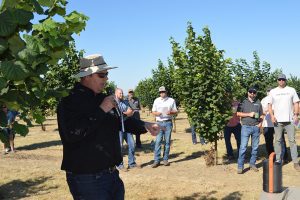
Orchard Management
In another breakout session, Barney Kropf, a partner in K&D Systems, explained some of the thought processes behind his company’s farm management practices, including burying drip lines. In addition to eliminating the damage from coyotes and other pests, which was the main reason behind burying the lines, the practice has proven beneficial at harvest, he said, because crews no longer are worried about tearing up lines with equipment. Also, he said, the farm is no longer losing water to evaporation.
“There are a lot of benefits,” he said.
He added that the farm leaves drip lines above ground for the first two years of an orchard to ensure water gets right on the roots.
Kropf also talked about the farm’s use of grass between rows. “We like the fact that in the winter, we can get out into the field and get stuff done,” he said. And the grass has benefits during harvest as well, he said. “If we have a rain event, we can get out there faster.”
Kropf said he mows probably five times a year in a typical year. This year, because of the rainy spring, he mowed probably six times, he said.
Soil Microbes
Victoria Marsh of the specialty fertilizer company Tessenderlo Kerley also spoke about the advantages of incorporating grass into orchard alleys during her breakout session on soil microbes.
“This alone is going to be the biggest thing you can do to boost soil health,” Marsh said. Grass helps water filtration, nutrient uptake and decreases compaction in alleys, she said.
“Living roots provide multiple benefits,” she said.
Steep Growth Curve
A recurring theme during the 2022 Summer Tour and Trade Show, starting with the opening presentation from Nut Growers Society President Cathy Bisset, was the rapid growth rate of the Oregon hazelnut industry.
In the late 1990s, Bisset said, the Summer Tour was an informal event that concluded with a potluck picnic. “At the time, we had 20,000 acres,” Bisset said. Today, she said, more than 1,000 Oregon farms produce 99% of the U.S. supply of hazelnuts on roughly 90,000 acres.
In his presentation, Sean Denfeld, another partner in the receiving station, noted that the growth curve of the Oregon hazelnut industry is steeper than even the California walnut or almond industries. “Between 2016 and 2018, Oregon planted over 30% of its total area in just three years,” Denfeld said.
“Our growth curve has been incredibly steep,” he said.
Tim Newkirk, a former Nut Grower of the Year and past CEO of Willamette Hazelnut Growers, added that it is important for Oregon growers to maintain their current reputation for producing a quality nut.
“It is really important that we keep that intact,” Newkirk said. “And that all starts with the growers and how we take care of the crop.”
Newkirk also encouraged growers to help spread out the workload for handlers and processors during harvest by getting nuts in early.
“You want to get that product to the wash and dry station in a timely manner so that they have the time to move this volume through in an efficient state to the processor, so that they can get that product to market and we can maintain that quality,” he said.
